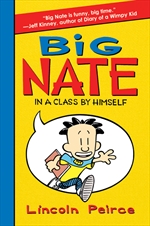 I know, I know. You saw the movie. “It was a little sad,” I hear you say. “My kid cried,” you say. I have no idea what happened when How to Train a Dragon, by Cressida Cowell, was turned into a movie, but something seems to have been lost in translation. This book is funny. Monty bloody Python funny. It’s not sad. I didn’t see the movie, so I’m not criticizing it, I’m just sayin’, boys LOVE this book. It definitely will not make them cry, unless they are laughing so hard a few tears spring from their eyes. Girls like it, too, if you can get them past the overtly male window dressing (Colors of the dragon breed called the Gronkle: Snot green, bogey beige, pooey brown.) and into the bones of the story. Because deep down, it’s universally appealing. Unlikely hero, whose talents fly in the face of popular culture, overcomes bully-ish peers by virtue of said talent, and saves the day. It reminds me of Python’s Life of Brian, in which Brian is believed by a whole lot of folks to be the Messiah, and feels wholly unfit for the job. (In case you want to remember, http://www.youtube.com/watch?v=Zjz16xjeBAA )
I know, I know. You saw the movie. “It was a little sad,” I hear you say. “My kid cried,” you say. I have no idea what happened when How to Train a Dragon, by Cressida Cowell, was turned into a movie, but something seems to have been lost in translation. This book is funny. Monty bloody Python funny. It’s not sad. I didn’t see the movie, so I’m not criticizing it, I’m just sayin’, boys LOVE this book. It definitely will not make them cry, unless they are laughing so hard a few tears spring from their eyes. Girls like it, too, if you can get them past the overtly male window dressing (Colors of the dragon breed called the Gronkle: Snot green, bogey beige, pooey brown.) and into the bones of the story. Because deep down, it’s universally appealing. Unlikely hero, whose talents fly in the face of popular culture, overcomes bully-ish peers by virtue of said talent, and saves the day. It reminds me of Python’s Life of Brian, in which Brian is believed by a whole lot of folks to be the Messiah, and feels wholly unfit for the job. (In case you want to remember, http://www.youtube.com/watch?v=Zjz16xjeBAA )
Only, nobody believes in Hiccup.
Hiccup is a Viking boy, heir to the royal throne. His father, the Chief of the Hairy Hooligans, casts a long shadow– he’s a fearsome sword warrior and esteemed leader of a crowd who favors brawn and bulkiness over all else. Hiccup is more of the introspective, intellectual sort of Viking. The problem is, of course, there is no such thing as an introspective, intellectual Viking, and most definitely no such thing as an introspective, intellectual Viking chief. Hiccup is routinely ridiculed by fellow tribesman, including his father. A rite of passage for all Viking boys is to tame a wild dragon to use in battle. The book opens with the boys being led into a cave to kidnap sleeping baby dragons during their hibernation season. The popular mode of training a dragon? Yell at it. The louder the better. Hiccup has a wimpy yell, and all his peers know his weakness. On top of that, he’s captured the smallest of all dragons– and it’s toothless, to boot. But Hiccup’s strength? He’s researched and studied, studied and researched, and mastered the Dragonese language. He’s a dragon whisperer.
What adult doesn’t want his/her child getting the message that brains overpower brawn? The best part is that it’s camouflaged in kid humor. The line-up of events at the “Thor’sday Thursday Celebration?” Hammer-throwing for the Over-60s only; How Many Gulls’ Eggs Can You Eat in One Minute? contest; Ugliest Baby Contest; Axe-fighting Display (“Admire the delicate art of fighting with axes.”).
A whole lot of fun, and just the beginning of a multi-book series. So forget the movie. The book is better (she says without having seen the first frame of the film). Isn’t the book always better?














